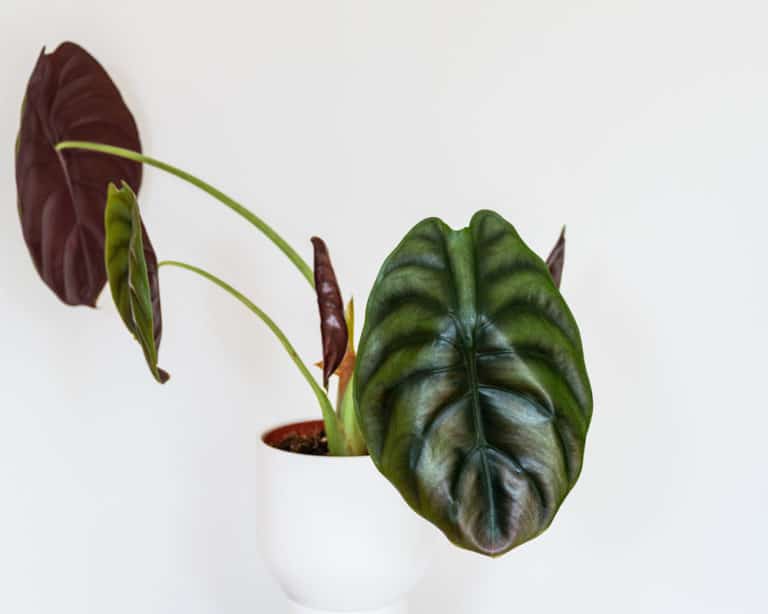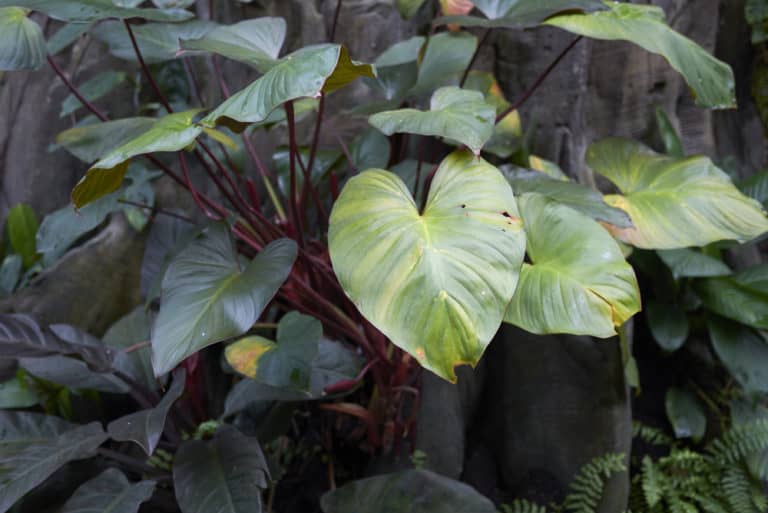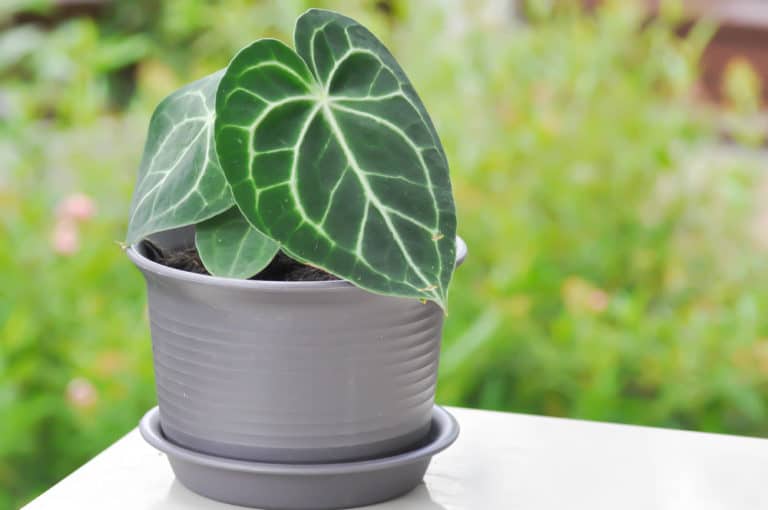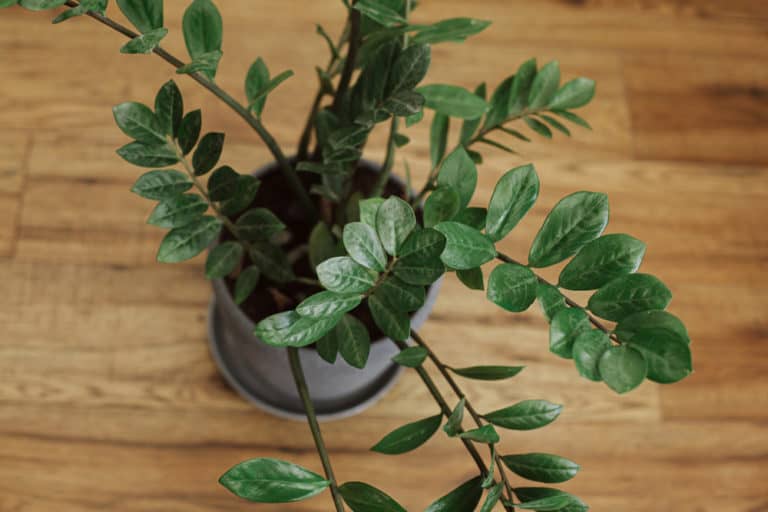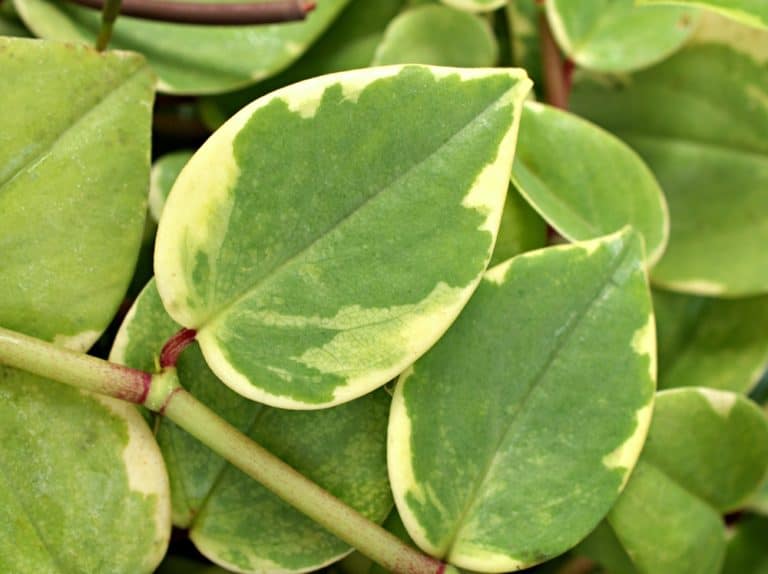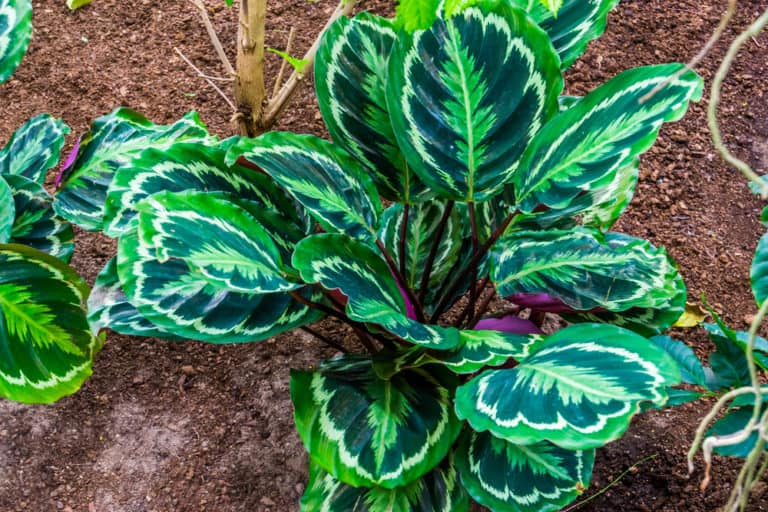Caladium Praetermissum ‘Hilo Beauty’ Care Guide (2024)
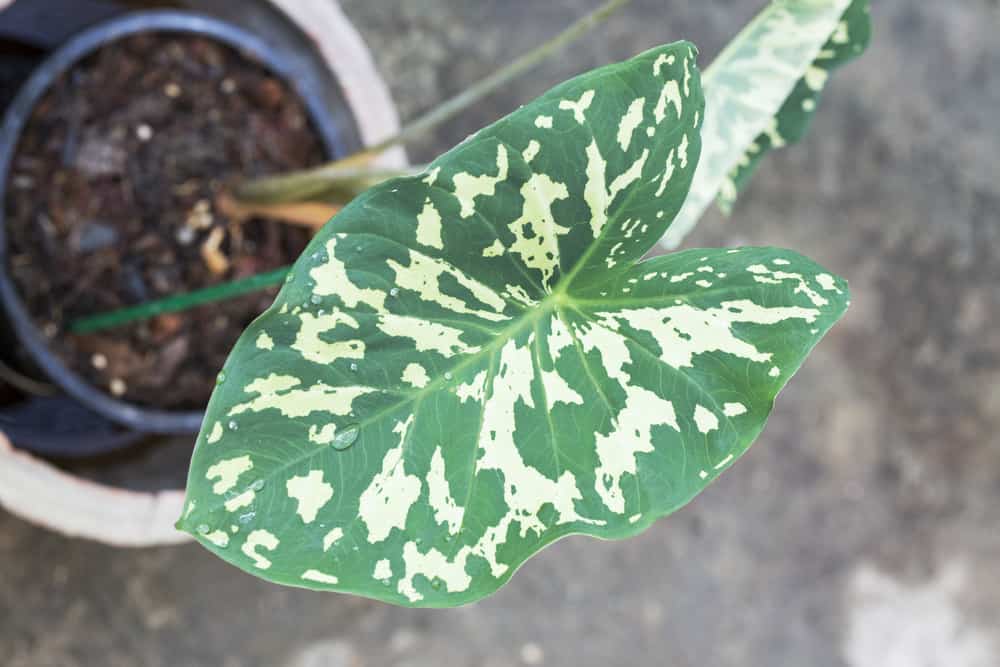
Caladium praetermissum, also known as alocasia hilo beauty, is a popular houseplant, and with good reason. With its dramatic appearance and undemanding cultivation needs, it’s a perfect choice in indoor settings. Of course, if you live in a frost-free climate, or are looking for a great summer-long show of foliage, this native of Brazil is also a great specimen for planting outdoors!
| Scientific Name | Caladium praetermissum |
| Common Name | Alocasia ‘Hilo Beauty’ |
| Light | Bright indirect sunlight |
| Watering | Water if top half of soil is dry |
| Temperature | 65-90°F (18-32°C) |
| Hardiness Zone | 9-11 |
| Humidity | 50-80% |
| Soil Type | Rich, quick-draining, peaty |
| Soil pH | 5.5 to 6.5 (mildly acidic) |
| Fertilizing | Balanced half-strength every few weeks in growing season |
| Repotting | Every 2 years |
| Pruning | Rarely |
| Propagation | Divide tubers and replant |
| Toxicity | Toxic to humans and pets |
| Mature Size | 24-48 inches |
| Bloom Time | Foliage show from early summer to frost |
What’s Unique About Caladium praetermissum?
The Caladium praetermissum plant is notable for the size and beauty of its leaves. It’s also known as “Elephant Ears” because of the size and shape of its strikingly patterned leaves.
Hilo Beauty has heart-shaped leaves up to a foot in length, covered with an irregular pattern in various shades of cream and green, arching out gracefully from the tips of a clump of stems standing up to 4 feet tall.
This makes it an excellent accent plant for an indoor setting, or outdoors in a tropical garden where its height and coloring will make it a natural focal point.
Caladium praetermissum Care
Caladium praetermissum plant care is not complicated. As long as you understand how its cultivation needs are influenced by its tropical origins, you should be able to keep this tender perennial thriving for years to come.
Regular light watering, occasional fertilization, and a bright spot out of direct sunshine is the best alocasia hilo beauty care.
Light
Caladium praetermissum light requirements are linked to where these beauties originated.
While you might assume that a plant native to the tropics would thrive in full sun, they need a less intense level of light to avoid burning their leaves. In their native jungle setting they would have filtered sunshine .
On the other hand, if they don’t get enough light, they can drop their leaves. You’re aiming for between 15,000 to 35,000 lux.
You can place it within a few feet of a south or west-facing window while keeping it out of the direct rays of the sun. In a less sunny space, you should use a grow light to provide the alocasia hilo beauty light needs.
Watering
Caladium praetermissum watering requirements are pretty straightforward. In their native environment of the tropical jungle, they are used to well-drained but consistently moist soil.
The best way to meet its watering needs is with regular light watering, probably on a daily basis, but certainly several times a week.
Whenever the top of the soil appears dry, give it enough water to moisten the soil, but do not let it sit in water once the soil has been thoroughly wetted, or the tuber will rot.
In the winter, it may go dormant, and then you should cut back on the frequency of watering. Water alocasia hilo beauty like this and it will continue to thrive.
Temperature
Alocasia hilo beauty is a native of the tropics, so it’s no surprise that the Caladium praetermissum temperature range is on the hot side.
It will thrive in temperatures ranging from 70 to 90 degrees Fahrenheit (21-32° Celsius) during the day, and no lower than 65°F (18°C) at night.
They can suffer damage if exposed to temperatures lower than 60°F (15° C), and have so little frost hardiness that 35°F (1° C) can kill them.
If you cannot ensure outdoor temperatures within that range, you will best be able to maintain the acceptable temperature for alocasia hilo beauty indoors.
You may opt for growing Caladium praetermissum in pots that can be moved from outdoors in hot weather to indoors when it grows colder.
Humidity
The ideal humidity for alocasia hilo beauty is, in a word, high. This tropical plant needs a humidity level ranging from 50 to 80 percent to keep it in top condition; otherwise, it can develop brown leaf tips.
This is obviously much higher than the average indoor environment, but there are ways to deal with this issue without turning your home into a sauna.
You can meet the Caladium praetermissum humidity requirements by misting the plants on a daily basis, or by placing the pot atop a tray filled with pebbles and water.
You can also enclose hilo beauty in a terrarium where the moisture is recycled in a sealed system.
Soil
The best soil for alocasia hilo beauty is a loose, rich soil that can hold moisture but at the same time drain the excess water so that the plant’s tubers will not rot in wet soil.
The ideal pH level for alocasia hilo beauty is between 5.5 to 6.5, or mildly acidic.
Aim for a mixture of peat moss, perlite, and potting soil to achieve the ideal pH balance as well as creating a well-draining but moist soil mix.
You can blend your own custom Caladium praetermissum soil, or opt to use a commercial peat-based formula with equal success.
Fertilizer
Using fertilizer for alocasia hilo beauty will result in the faster growth of larger and more colorful leaves, so it’s worth making the effort to keep it well fed.
You don’t need to look for a specific Caladium praetermissum fertilizer. Start by adding a slow-release fertilizer when you pot up the plant. Then, supplement with a water-soluble balanced fertilizer (a 1-1-1 N-P-K fertilizer ratio is ideal). Dilute it to half the recommended strength and apply it every few weeks in summer. Stop fertilizing in winter when the plant goes into dormancy.
You will know if you’re fertilizing too much if leaves turn brown or lose their vivid colors. If that occurs, flush the soil to rid it of accumulated salts.
Potting & Repotting
If you bought your Caladium praetermissum already potted, you will be able to keep it in that container until it outgrows it. Every couple of years, when it outgrows its original pot, roots will start growing out of the drainage holes.
Then it’s time for repotting alocasia hilo beauty. You don’t want to go up to too big a pot size; only increase it by a couple of inches in diameter.
Also make sure that the pot has adequate drainage holes, as the tubers will not tolerate waterlogged soil.
And use a potting soil as outlined above. This should make your Caladium praetermissum repotting a success.
Pruning
You will rarely need to trim Caladium praetermissum, as it naturally achieves a graceful shape.
The only Caladium praetermissum pruning that might be necessary is removing yellowing leaves as they start to die.
You might also want to cut some leaves to include in a flower arrangement. In both cases, the most effective way of cutting alocasia hilo beauty is removing the entire stem with a sharp knife at soil level.
However, if you want to create a bushier plant with more stems, cut out the central bud where it emerges from the tuber to encourage the growth of more secondary stems.
Propagation
Caladium praetermissum propagation is really easy and can provide you with more of these lovely tropical plants for yourself or others.
The most common—and easiest—method to propagate alocasia hilo beauty is by division of tubers.
Carefully lift the clump of tubers out of the soil, and using a sharp, sterilized knife, cut them apart, making sure there’s at least one bud or growing point on each.
Plant them in moist potting soil in individual pots, with the buds facing up and covered with two inches of soil.
Keep them around 70 degrees Fahrenheit (21° Celsius) and you should soon see new sprouts emerging.
Common Problems of Caladium praetermissum
You can expect to have a few problems with alocasia hilo beauty, but there are some things that you need to look out for.
If the leaves start to show some discoloration or holes, it’s probably time to get out the insecticidal soap. Browning of leaves may indicate a fungal disease or too sunny a location.
Luckily there are solutions for these Caladium praetermissum problems.
Pests
One of the great things about growing alocasia hilo beauty in your home or garden is that there are few bugs that cause problems for these showy plants.
If you see little fluffy spots, mealybugs have found your plants, while a sticky substance or black mold probably means aphids.
Tiny holes and yellow spots indicate the presence of spider mites, and little clusters of bumps are typical of scale insects.
Luckily, all of these Caladium praetermissum pests can easily be kept under control by spraying the leaves every couple of weeks with insecticidal soap.
It’s really important to make sure that you cover the entire plant, including the underside of the leaves, to get all of the bugs.
Diseases
The most likely of Caladium praetermissum diseases are fungal, and it’s best to prevent their development rather than curing the disease once it’s established.
The signs of a fungal infection are brown splotches on the leaves, or in more extreme cases, rotting tubers.
Nip any potential problems in the bud by soaking tubers before storing or planting in water heated to 122° F (50° C) for half an hour to kill the fungi.
Once your alocasia hilo beauty is growing in its pot, keep the soil moist but not sopping wet, as those conditions can encourage the development of fungal disease.
Growing Problems
One of the reasons that Caladium praetermissum is such a popular plant both for houseplants and landscaping is that they do not suffer from many growing problems.
However, when planted outdoors, deer and rabbits might try to nibble on them, and animals such as squirrels might dig up the tubers.
You can protect them from squirrels by wrapping the tubers loosely in chicken wire when planting, and you might be able to keep bigger animals out with fencing.
You might also have a sick plant if it’s too suddenly exposed to full sunlight after growing in a more shaded spot, resulting in browning leaves.
Either transplant to a spot with more shade or provide protection from the hot afternoon sun.
Toxicity of Caladium praetermissum
As beautiful as alocasia hilo beauty is, it is not without risk in the home and garden.
All parts of the plant have a sap containing calcium oxalate crystals, as well as a protein called asparagine, both of which are toxic to people and pets.
In fact, the level of toxicity is so high that children and animals can die if they ingest too much.
For Humans
Caladium praetermissum is definitely toxic for all humans, and is especially dangerous for children. The sap and all parts of the plant can cause a rash, so if you have sensitive skin it’s best to limit contact.
Thorough rinsing with water should help, and you can use allergy creams to soothe an adverse reaction. Avoid contact with eyes and mouth. Adults are unlikely to actually eat the leaves, but children can be attracted to their enticing colors and try a taste.
They may develop trouble breathing as their airways swell up, and may get a swollen tongue or nose.
If you suspect that a child has ingested caladium praetermissum, you should take them to an emergency room, as there is a risk of coma or even death if they ate enough.
For Pets
Pet owners also need to be careful around Caladium praetermissum. Cats, dogs, rabbits and horses can all be poisoned if they eat the leaves of this plant.
If a cat or dog starts drooling excessively or vomiting, or pawing at their face, there is a chance it could be from ingesting this toxic plant.
Contact a veterinarian if you suspect exposure.
For a topical exposure, where the pet has the sap on its skin, you should be able to treat them at home, but if the cat or dog has eaten the plant, you will probably need to take them in for treatment.
To prevent this from happening, find ways to display plants that pets cannot reach, such as hanging baskets.
Caladium praetermissum Appearance
The Caladium praetermissum appearance is all about the leaves.
Large and heart-shaped, they’re bright green with a dramatic pattern of creams and light greens, arching out in a graceful shape at the end of slender stems.
This plant is picture-perfect for indoor planting year-round, or outside in hot summer weather.
Foliage
The foliage of Caladium praetermissum is definitely the star of the show.
This tropical native produces large, heart-shaped leaves covered in irregular patterns similar to camouflage, in shades ranging from cream to green against a bright green background.
Each paper-thin leaf grows from the tip of a separate long, slender stem, arching out gracefully from a central clump.
With a fully grown size of up to a foot in length, the leaves are nothing short of spectacular, and each will last for months before the plant goes into dormancy in winter.
The leaves should be left until they turn brown, when the stems can be cut off at the soil surface.
Flowering
Caladium praetermissum flowering does occur, but is not what makes this plant so desirable.
It’s a rare event; the first known specimen of this variety at the Botanical Garden of Munich has only bloomed twice in over 40 years.
In the unlikely event that you get an alocasia hilo beauty flower, expect to see a stem less than a foot in height with small cream or light green colored upright tightly-wrapped sheathes similar to a calla lily.
Summer is the most likely blooming period, but there is no guarantee that your plants will bloom then, or ever. Grow Caladium praetermissum instead for the beauty of its long-lasting leaves.
Size and Growth
Tubers are planted, usually in spring, and rapid growth continues until caladium praetermissum dies back and goes dormant in fall. This dramatic plant can grow to be as much as 4 feet tall, and as wide across.
Long, slender stems sprout up from the buried tuber and the characteristic large, heart-shaped leaves grow from their tips.
The growth rate and size of Caladium praetermissum will depend on the size of the tuber—jumbo bulbs will grow faster. Expect to see a fully grown plant within two months from sprouting.
You can encourage bushier growth by cutting out the central bud from the tuber so that more stems will spring up.
Caladium praetermissum Fragrance
Since this foliage plant blooms so rarely, there is little information recorded about whether caladium praetermissum produces a fragrance.
There is no scent associated with the foliage, and it is possible that Caladium praetermissum fragrance, if any, is of a pleasant nature. It is likely a light citrus scent as with other caladiums, and would certainly only last as long as the brief period of flowering.
On the whole, it is best to assume that alocasia hilo beauty will not be a fragrant plant, even in an indoor setting, making it a good choice for people with a sensitivity to strong scents.
Suggested Uses for Caladium praetermissum
Caladium praetermissum is an excellent choice, indoors or out, when you’re looking for a specimen plant to be a focal point.
With its height and large, dramatic leaves, it’s going to be a true conversation piece. Plant one tuber per pot to best show off the graceful, arching shape of the slender stems as they curve out to showcase the splashy leaves.
Use a potted Caladium praetermissum to fill in an empty corner in a living room.
Outdoors, you can use them in pots or plant directly in the soil to quickly create a tropical feel, especially in a poolside garden or on a patio where they can be fully appreciated.
Caladium praetermissum Varieties
Caladium praetermissum was only discovered about 40 years ago and there are no other Caladium praetermissum varieties. “Hilo Beauty” is the only known variety.
However, there are many hundreds of other caladium varieties that are cultivated for their lush, beautiful foliage. There’s a wide selection of colors and patterns to choose from, ranging from brilliant reds, to crisp greens to bright whites.
They have basically the same requirements as Caladium praetermissum: warm temperatures and moist, well-drained soil. Some, however, will thrive in full sun while others prefer deep shade, giving you many different planting options indoors and outside. A few of the many possibilities are listed below.
Caladium ‘Pink Beauty’
Caladium ‘Pink Beauty’ is a very popular Caladium variety, with its bright pink and green leaves that grow up to a foot long on plants up to 3 feet high
Caladium ‘Red Ruffles’
Caladium ‘Red Ruffles’ features deep red leaves with green margins, growing in a lush clump a foot high.This variety can tolerate more direct sun than Caladium praetermissum.
Caladium ‘Autumn Beauty’
This variety has vivid lime green leaves highlighted with brilliant pink-red veins. The foliage matures to a rich bronze in the fall. The plant grows to 20 inches in height and spread.
Caladium ‘Tapestry’
Caladium ‘Tapestry’ has cream-colored centers edged with brilliant green, bisected with bright red veins. This variety grows to 3 feet and prefers semi-shade to shady locations, as well as indoor settings.
Caladium ‘Strawberry Star’
This caladium variety will thrive in sun or shade, and features white leaves laced with bright green veins, as well as splotches of pink scattered across them. The growth habit is very similar to Caladium praetermissum.
Caladium ‘Icicle’
This variety has bright white leaves with a narrow edging of brilliant deep green. Mature leaves are 9-11 inches long and grow in a lush clump up to a foot tall.
FAQ
What is Caladium praetermissum?
Caladium praetermissum is also called alocasia ‘Hilo Beauty’. It is a variety of caladium that was first found in the 1980’s in the Munich Botanical Garden.
How to identify Caladium praetermissum?
Caladium praetermissum has large, heart-shaped green leaves patterned with cream and light green splotches. They grow from the tips of slender stems which reach to 4 feet high.
How to care for Caladium praetermissum?
Caladium praetermissum does not need a lot of special attention. Provide it with bright, filtered sunshine and consistently moist soil for a long season of spectacular foliage.
How to grow Caladium praetermissum indoors?
Plant a tuber in a pot with peat-based soil and place it in a bright spot but out of direct sun. Water when the top 2 inches of the soil are dry.
How to grow Caladium praetermissum outdoors?
Plant tubers two inches below the soil surface and keep them well-watered. Caladium praetermissum will do best in a semi-shade location with consistently moist soil.
How fast does Caladium praetermissum grow?
Caladium praetermissum stems and leaves will start to develop in a few weeks, and will grow to its full height within a couple of months of planting.
How tall does Caladium praetermissum grow?
Caladium praetermissum can range in height from 2 to 4 feet, with a spread of up to 3 feet, depending on the size of the tubers.
How to make Caladium praetermissum grow faster?
Caladium praetermissum will grow its fastest when provided with the heat and moisture that they love. Keep them between 70 and 90°F and they will thrive.
How to stake Caladium praetermissum?
Caladium praetermissum does not require staking. The long, slender stems are strong enough to support the leaves on their own.
How to pot Caladium praetermissum?
Use a peat-based soil mixture in a pot with drainage holes. Set the tuber 2 inches under the soil surface and keep the soil moist but not soggy.
How to revive Caladium praetermissum?
Caladium praetermissum will naturally go dormant in the fall. You can lift the tubers and store in peat or vermiculite until spring when you can replant them.
Why is my Caladium praetermissum dying?
If it’s fall, your Caladium praetermissum is going through its normal life cycle and entering dormancy. Trim off the dead stems and save the tubers to replant in the spring.
Why is my Caladium praetermissum drooping?
If the soil is dry, keep it moist, but if it’s too wet, you should repot it with better drainage. If there is a build-up of salts, flush the soil thoroughly.
How cold can Caladium praetermissum tolerate?
Temperatures lower than 60°F (15° C) can damage the foliage, and 35°F (1° C) can kill them. Outdoors, dig up tubers before a frost, and keep potted plants in a warm spot indoors.
How to get rid of pests on Caladium praetermissum?
Insecticidal soap sprayed on the top and underside of the leaves and stems will take care of most of the insect pests that affect Caladium praetermissum.
Is Caladium praetermissum toxic to cats?
Yes. Keep any member of the caladium family away from cats who might want to nibble on their leaves. Hanging baskets are a good way to ensure this.
Is Caladium praetermissum toxic to dogs?
Yes. If your dog has ingested Caladium praetermissum foliage and is showing signs of a swollen tongue or airways, take him to a veterinarian for treatment.
Is Caladium praetermissum toxic to children?
Yes. If your child is having difficulty breathing or has a swollen tongue and nose, you should seek medical help. Caladium poisoning can result in organ damage or death.
Is Caladium praetermissum toxic to humans?
Yes. While adults are unlikely to ingest the foliage and suffer serious injury, people with sensitive skin may have an allergic reaction to the sap.
Does Caladium praetermissum have a scent?
Caladium praetermissum flowers may have a slight fragrance, but they are rarely seen, and the foliage is scentless. They are grown for the beauty of the leaves, not their smell.

